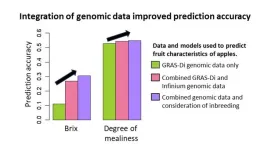(Press-News.org)
This study presents a significant advancement in fuel cell technology. Researchers from Tokyo Tech identified hexagonal perovskite-related Ba5R2Al2SnO13 oxides (R = rare earth metal) as materials with exceptionally high proton conductivity and thermal stability. Their unique crystal structure and large number of oxygen vacancies enable full hydration and high proton diffusion, making these materials ideal candidates as electrolytes for next-generation protonic ceramic fuel cells that can operate at intermediate temperatures without degradation.
Fuel cells offer a promising solution for clean energy by combining hydrogen and oxygen to generate electricity, with only water and heat produced as byproducts. They consist of an anode, a cathode, and an electrolyte. Hydrogen gas is introduced at the anode where it splits into protons (H+) and electrons. The electrons create an electric current, while the protons migrate through the electrolyte to the cathode, where they react with oxygen to form water. Most fuel cells are solid oxide fuel cells (SOFCs), which use oxide ion conductors as electrolytes. However, a major challenge with SOFCs is the high operating temperatures required, leading to material degradation over time. To address this, protonic ceramic fuel cells (PCFCs) that use proton-conducting ceramic materials as electrolytes are being explored. These fuel cells can operate at intermediate, more manageable temperatures of 200–500 °C. However, finding suitable materials that exhibit both high proton conductivity and chemical stability at these intermediate temperatures remains a challenge.
In a study published in the Journal of the American Chemical Society, researchers led by Professor Masatomo Yashima from Tokyo Institute of Technology (Tokyo Tech), in collaboration with researchers from Tohoku University, have made a significant breakthrough. They identified chemically stable hexagonal perovskite-related oxides Ba5R2Al2SnO13 (where R represents rare earth metals Gd, Dy, Ho, Y, Er, Tm, and Yb) as promising electrolyte materials with a high proton conductivity of almost 0.01 S cm⁻¹, which is notably higher than that of other proton conductors around 300 oC.
“In this work, we have discovered one of the highest proton conductors among ceramic proton conductors: novel hexagonal perovskite-related oxide Ba5Er2Al2SnO13, which would be a breakthrough for the development of fast proton conductors,” says Yashima.
The high proton conductivity of the material is attributed to the full hydration in highly oxygen deficient material with a unique crystal structure. The structure can be visualized as a stacking of octahedral layers and oxygen-deficient hexagonal close-packed AO3–δ (h’) layers (A is a large cation such as Ba²⁺ and δ represents the amount of oxygen vacancies). When hydrated, these vacancies are fully occupied by the oxygens from the water molecules to form hydroxyl groups (OH⁻), releasing protons (H⁺) which migrate through the structure, enhancing conductivity.
In their study, the researchers synthesized Ba5Er2Al2SnO13 (BEAS) using solid-state reactions. The material had a large amount of oxygen vacancies (δ = 0.2) and exhibited a fractional water uptake of 1, indicating its capacity for full hydration. When tested, its conductivity in a wet nitrogen environment was found to be 2,100 times higher than in a dry nitrogen environment at 356 °C. When fully hydrated, it achieved a conductivity of 0.01 S cm⁻¹ at 303 °C.
Moreover, the arrangement of atoms in the octahedral layers provides paths for proton migration, further increasing proton conductivity. In simulations of Ba5Er2Al2SnO13·H2O, the researchers studied proton movement in a 2×2×1 supercell of the crystal structure, represented by Ba40Er16Al16Sn8O112H16. This structure included two h’ layers and two octahedral layers. The researchers found that protons in the octahedral layer showed long-range migrations of protons, indicating fast proton diffusion.
“The high proton conductivity of BEAS is attributed to its high proton concentration and diffusion coefficient,” explains Yashima.
In addition to its high conductivity, the material is also chemically stable at the operating temperatures of PCFCs. Upon annealing the material under wet atmospheres of oxygen, air, hydrogen, and CO2 at 600 °C, the researchers observed no changes in its composition and structure, indicating the material's robust stability and suitability for continuous operation without degradation.
“These findings open new avenues for proton conductors. The high proton conductivity via full hydration and fast proton migration in octahedral layers in highly oxygen-deficient hexagonal perovskite-related materials would be an effective strategy for developing next-generation proton conductors,” says Yashima. With its exceptional properties, this material could lead to efficient, durable, and lower-temperature fuel cells.
###
About Tokyo Institute of Technology
Tokyo Tech stands at the forefront of research and higher education as the leading university for science and technology in Japan. Tokyo Tech researchers excel in fields ranging from materials science to biology, computer science, and physics. Founded in 1881, Tokyo Tech hosts over 10,000 undergraduate and graduate students per year, who develop into scientific leaders and some of the most sought-after engineers in industry. Embodying the Japanese philosophy of “monotsukuri,” meaning “technical ingenuity and innovation,” the Tokyo Tech community strives to contribute to society through high-impact research.
https://www.titech.ac.jp/english/
END
Over the past few decades, the world has witnessed tremendous progress in the tools used for genomic analysis. While it’s usually more common to associate these tools with the fields of biology and medicine, they have proven to be very valuable in agriculture as well. Using numerous DNA markers obtained from next-generation sequencing technologies, breeders can make genomic predictions and select promising individuals based on based on their predicted trait values.
Various systems and methodologies aimed at improving the ...
Immobilizing small synthetic molecules inside protein crystals proves to be a promising avenue for studying intermediate compounds formed during chemical reactions, report scientists from Tokyo Tech. By integrating this method with time-resolved serial femtosecond crystallography, they successfully visualized reaction dynamics and rapid structural changes occurring within reaction centers immobilized inside protein crystals. This innovative strategy holds significant potential for the intelligent design of drugs, catalysts, and functional materials.
Most complex chemical reactions, whether synthetic or biological, do not involve ...
Prejudice against fat people is endemic in our society and public health initiatives aimed at reducing obesity have only worsened the problem, according to a U.S. academic.
In her new book Why It’s OK To Be Fat, Rekha Nath, an Associate Professor of Philosophy at the University of Alabama, argues for a paradigm shift in how society approaches fatness.
According to Nath, society must stop approaching fatness as a trait to rid the population of, and instead fatness should be approached through the lens of social equality, attending to the systematic ways that society penalizes fat people for their body size.
Nath explains: “Being fat is seen as unattractive, as gross even. ...
Up on the “roof of the world”, one of the world’s largest ecosystem restoration projects is taking place. The Qinghai-Tibetan Plateau (QTP) in western China is the world’s highest plateau and covers a land area roughly five times the size of France.
Home to thousands of rare plants and wildlife and the source of water for more than 2.5 billion people, this vital ecosystem is under threat.
The region’s grassland is degrading due to climate change and intense livestock grazing. Government ...
In a new study of politicians’ personalities, humour, charm and raw courage are listed among the most important character traits for successful leaders.
Bill Jones, Honorary Professor of Political Studies at Liverpool Hope University, has combed through biographies and interviewed key political figures to understand the kind of people who enter politics, and strengths and frailties of those who occupy positions of power.
Jones explains: “Why do aspiring politicians embark on such a perilous journey, involving hugely long hours, no real job security and, on occasions, high degrees ...
A pioneering study, presented today at the ESHRE 40th Annual Meeting in Amsterdam, has revealed that exposure to fine particulate matter (PM) prior to the retrieval of oocytes (eggs) during in vitro fertilisation (IVF) can reduce the odds of achieving a live birth by almost 40% [1].
The study analysed PM10 exposure in the two weeks leading up to oocyte collection, finding that the odds of a live birth decreased by 38% (OR 0.62, 95% CI 0.43-0.89, p=0.010) when comparing the highest quartile of exposure (18.63 to 35.42 µg/m3) to the lowest quartile (7.08 to 12.92 µg/m3).
Conducted ...
Gestational carriers, also known as surrogates, experience an elevated risk of severe maternal morbidity and adverse pregnancy outcomes compared to women who conceive naturally or through in vitro fertilisation (IVF), according to new research presented today at the ESHRE 40th Annual Meeting in Amsterdam [1].
The population-based study analysed 937,938 singleton births in Ontario, Canada between 2012 and 2021, comparing outcomes among unassisted conceptions, IVF conceptions and gestational carriers.
The findings uncovered marked variations in outcomes across the different conception methods. Gestational carriers faced a severe maternal morbidity rate ...
New research has demonstrated the effectiveness of a first-in-class oral, non-hormonal drug in increasing embryo implantation, pregnancy and live birth rates among infertile women who are undergoing in vitro fertilization (IVF) or intracytoplasmic sperm injection (ICSI) [1]. The findings, presented today at the ESHRE 40th Annual Meeting in Amsterdam, represent a significant step toward the first therapeutic tool to increase embryo implantation and live birth rate success.
Worldwide, one ...
A breakthrough for biomedical research promises new insight into immunotherapy development and disease modeling. Scientists at The University of Texas Health Science Center at San Antonio have created a humanized mouse model with a human immune system and a human-like gut microbiome that is capable of mounting specific antibody responses.
The scientists were led by Paolo Casali, MD, University of Texas Ashbel Smith Professor and Distinguished Research Professor, Department of Microbiology, Immunology and Molecular Genetics in the Joe R. and Teresa Lozano Long School of Medicine. Casali has five decades of biomedical research ...
At the upcoming SIAM Conference on Mathematics of Data Science (MDS24), a diverse mix of professionals from universities, industry, government, and research labs are set to join. The conference will showcase cutting-edge research that advances mathematical, statistical, and computational methods in the context of what we do with data and how to do it better. Presentations will range from foundational theory of data science to diverse applications. A particular focus this year is on the interaction of data science with the broader society in terms of privacy, interpretability, explainability, ...






